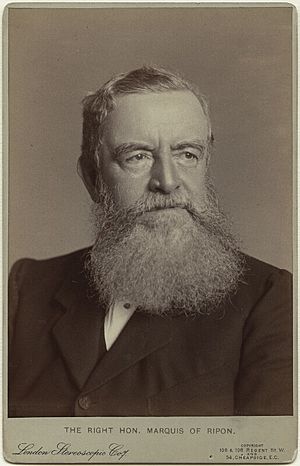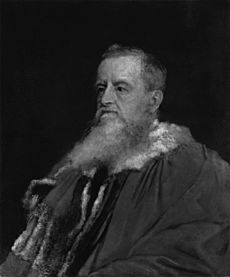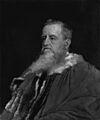George Robinson, 1st Marquess of Ripon facts for kids
Quick facts for kids
The Most Honourable
The Marquess of Ripon
|
|
|---|---|
 |
|
| Leader of the House of Lords Lord Keeper of the Privy Seal |
|
| In office 10 December 1905 – 14 April 1908 |
|
| Monarch | Edward VII |
| Prime Minister | Sir Henry Campbell-Bannerman |
| Preceded by | The Marquess of Lansdowne (Leader of Lords) The Marquess of Salisbury (Lord Privy Seal) |
| Succeeded by | The Earl of Crewe |
| Secretary of State for the Colonies | |
| In office 18 August 1892 – 21 June 1895 |
|
| Monarch | Queen Victoria |
| Prime Minister | William Ewart Gladstone The Earl of Rosebery |
| Preceded by | The Lord Knutsford |
| Succeeded by | Joseph Chamberlain |
| First Lord of the Admiralty | |
| In office 1 February 1886 – 20 July 1886 |
|
| Monarch | Queen Victoria |
| Prime Minister | William Ewart Gladstone |
| Preceded by | Lord George Hamilton |
| Succeeded by | Lord George Hamilton |
| Viceroy and Governor-General of India | |
| In office 8 June 1880 – 13 December 1884 |
|
| Monarch | Queen Victoria |
| Preceded by | The Lord Lytton |
| Succeeded by | The Earl of Dufferin |
| Lord President of the Council | |
| In office 9 December 1868 – 9 August 1873 |
|
| Monarch | Queen Victoria |
| Prime Minister | William Ewart Gladstone |
| Preceded by | The Duke of Marlborough |
| Succeeded by | Henry Bruce |
| Secretary of State for India | |
| In office 16 February 1866 – 26 June 1866 |
|
| Monarch | Queen Victoria |
| Prime Minister | The Earl Russell |
| Preceded by | Charles Wood |
| Succeeded by | Viscount Cranborne |
| Secretary of State for War | |
| In office 28 April 1863 – 16 February 1866 |
|
| Monarch | Queen Victoria |
| Prime Minister | Lord Palmerston The Earl Russell |
| Preceded by | Sir George Cornewall Lewis, Bt |
| Succeeded by | Marquess of Hartington |
| Parliamentary Under-Secretary of State for India | |
| In office 21 January 1861 – 31 July 1861 |
|
| Monarch | Queen Victoria |
| Prime Minister | Lord Palmerston |
| Preceded by | Hon. Thomas Baring |
| Succeeded by | Hon. Thomas Baring |
| Parliamentary Under-Secretary of State for War | |
| In office 31 July 1861 – 28 April 1863 |
|
| Monarch | Queen Victoria |
| Prime Minister | Lord Palmerston |
| Preceded by | Hon. Thomas Baring |
| Succeeded by | Marquess of Hartington |
| In office 18 June 1859 – 21 January 1861 |
|
| Monarch | Queen Victoria |
| Prime Minister | Lord Palmerston |
| Preceded by | The Earl of Rosslyn |
| Succeeded by | Hon. Thomas Baring |
| Member of the House of Lords Lord Temporal |
|
| In office 28 January 1859 – 9 July 1909 Hereditary Peerage |
|
| Preceded by | The 1st Earl of Ripon |
| Succeeded by | The 2nd Marquess of Ripon |
| Member of Parliament for West Riding of Yorkshire |
|
| In office 24 April 1857 – 28 January 1859 |
|
| Preceded by | Richard Cobden |
| Succeeded by | John William Ramsden |
| Member of Parliament for Huddersfield |
|
| In office 22 April 1853 – 24 April 1857 |
|
| Preceded by | William Crompton-Stansfield |
| Succeeded by | Edward Akroyd |
| Member of Parliament for Kingston upon Hull |
|
| In office 31 July 1852 – March 1853 |
|
| Preceded by | Matthew Talbot Baines |
| Succeeded by | William Digby Seymour |
| Personal details | |
| Born | 24 October 1827 10 Downing Street, London |
| Died | 9 July 1909 (aged 81) Studley Royal Park, North Yorkshire |
| Nationality | British |
| Political party | Liberal |
| Spouse |
Henrietta Vyner
(m. 1851; died 1907) |
George Frederick Samuel Robinson, 1st Marquess of Ripon (born October 24, 1827 – died July 9, 1909) was an important British politician. He also served as the Viceroy and Governor General of India, which meant he was the highest British official in India. He was a member of the Liberal Party and held many different government jobs between 1861 and 1908.
Contents
Who Was Lord Ripon?
George Robinson was known by several titles during his life. He was called Viscount Goderich from 1833 to 1859, then the Earl of Ripon in 1859. From 1859 to 1871, he was known as the Earl de Grey and Ripon. Finally, in 1871, he became the 1st Marquess of Ripon. He was a key figure in British politics for many years.
Early Life and Education
George Robinson was born in 10 Downing Street, London, which is where the British Prime Minister lives. His father, F. J. Robinson, 1st Viscount Goderich, was actually a Prime Minister himself and later became the Earl of Ripon. George was taught at home and did not go to a regular school or college.
In 1870, he received an honorary degree from the University of Oxford. This was a special award given to him for his achievements.
Starting a Political Career
Even though his father was a Tory (a different political party), George Robinson started his political journey as a Whig and later joined the Liberal Party. He first became a member of the House of Commons (part of the British Parliament) in 1852, representing Hull.
He later represented Huddersfield in 1853 and the West Riding of Yorkshire in 1857. In 1859, he inherited his father's title and moved to the House of Lords, which is the other part of the British Parliament.
Important Roles in Government
Lord Ripon held many important positions in the British government. He was known for being part of every Liberal government cabinet between 1861 and 1908.
Secretary of State for War and India
From 1859 to 1861, and again from 1861 to 1863, he was the Under-Secretary of State for War. This meant he helped manage the country's army. For a short time in 1861, he was also the Under-Secretary of State for India, helping with matters related to British India.
In 1863, he became the main Secretary of State for War and joined the Cabinet, which is a group of the most important government ministers. He kept this job when Lord Russell became Prime Minister. From February to June 1866, he served as Secretary of State for India.
Leading the Council and Treaty of Washington
In Gladstone's first government (1868–1873), Lord Ripon was the Lord President of the Council. This was a very senior role. During this time, he led a special group that helped create the Treaty of Washington. This treaty helped solve disagreements between Britain and the United States, especially about the "Alabama Claims" (which were about ships built in Britain for the Confederacy during the American Civil War).
Because of his important work on this treaty, he was given the special title of Marquess of Ripon in 1871. He had also been made a Knight of the Order of the Garter in 1869, which is a very high honor.
Viceroy of India: Making a Difference

When Gladstone became Prime Minister again in 1880, he chose Lord Ripon to be the Viceroy of India. This was a very powerful job, as the Viceroy was the Queen's representative and the head of British rule in India. Lord Ripon held this position until 1884.
Helping Indians and Farmers
During his time in India, Lord Ripon tried to introduce new laws to give Indian people more legal rights. One important effort was the Ilbert Bill. This bill would have allowed Indian judges to hear cases involving Europeans. However, many Europeans living in India did not like this idea, and the bill faced strong opposition.
Lord Ripon also worked to improve the lives of farmers in Bengal. He was supported by Florence Nightingale in his efforts to pass a land law that would help peasants. This eventually led to the Bengal Tenancy Act 1885. In 1882, he also removed the unpopular Vernacular Press Act of 1878, which had limited freedom of the press for Indian-language newspapers. He also helped create the Indian Famine Codes, which were rules to help manage famines.
Protecting Forests and Wildlife
Lord Ripon also played a key role in supporting Dietrich Brandis to improve the Madras Forest Department. He helped expand efforts to manage forests in a sustainable way and protect nature in India.
He is still remembered in Chennai (formerly Madras), India, where people affectionately called him "Lord Ripon engal appan," meaning "Lord Ripon, our father." The Ripon Building in Chennai and the town of Riponpet in Karnataka are named after him. In Calcutta, Ripon Street bears his name. The Clock Tower of Multan in Pakistan was also named Ripon Building, and its main hall was called Ripon Hall. The Ripon Club in Mumbai, founded in 1884 by the Parsi community, was also named in his honor.
Later Political Life
After his time as Viceroy of India, Lord Ripon continued his political career. He became a supporter of Home Rule for Ireland, which meant giving Ireland more control over its own affairs.
In Gladstone's government of 1886, he was the First Lord of the Admiralty, in charge of the navy. From 1892 to 1895, he was the Secretary of State for the Colonies, overseeing British colonies around the world. When the Liberal Party returned to power in 1905, he took on two more important roles at the age of 78: Lord Privy Seal and Leader of the House of Lords. He retired from these roles in 1908.
Other Important Roles
Lord Ripon held many other important positions outside of government. He was the President of the Royal Geographical Society from 1859 to 1860 and a Trustee of the National Gallery.
He also had many public roles in Yorkshire, where he lived. He was an honorary Colonel in a military regiment, the High Steward of Hull, and the Lord Lieutenant of the North Riding of Yorkshire from 1873 to 1906. He also served as the Mayor of Ripon in 1895–1896.
Freemasonry and Faith
Lord Ripon was a Freemason, a member of a social and charitable organization. He held high positions within the Freemasons, including Grand Master from 1870. However, he left this role in 1874 when he converted to Catholicism. After becoming Catholic, he generously supported Catholic schools and charities. He was president of the Society of St Vincent de Paul from 1899 until his death.
Supporting Education
Lord Ripon was also the first Chancellor of the University of Leeds when it was created in 1904. He held this position until his death in 1909, showing his commitment to education.
Family Life
Lord Ripon married his cousin, Henrietta Anne Theodosia Vyner, on April 8, 1851. They had one son and one daughter:
- Frederick Oliver Robinson, 2nd Marquess of Ripon (born January 29, 1852 - died September 22, 1923)
- Mary Sarah Robinson (born July 16, 1857 - died July 3, 1858)
Death
Lady Ripon passed away in February 1907. Lord Ripon died two years later, in July 1909, at the age of 81, due to heart failure. He was buried at St Mary's, Studley Royal. His only son, Frederick Oliver, inherited his titles.
Images for kids
-
Lord Ripon by George Frederic Watts




